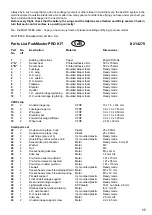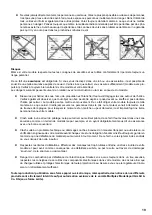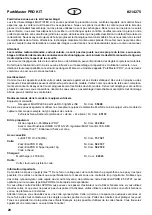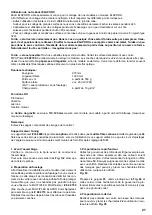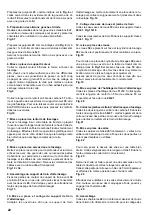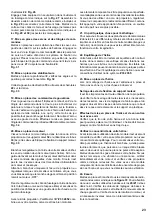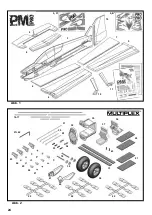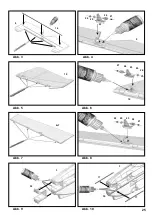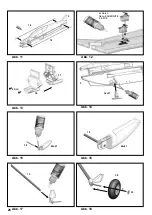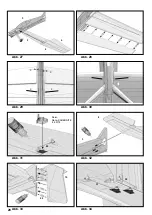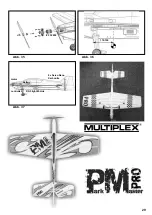
14
5. Preparing the left and right ailerons
Here again use a balsa knife to cut slots for the hinges
22
at the marked points in the ailerons
6 + 7
, cutting along the
centreline of the leading edge.
Fig. 7.
Prepare the aileron horns
23
as shown in
Fig. 8
(one left,
one right), and glue them in the recesses in the ailerons
6 + 7
. Secure each hexagon nut with a drop of glue.
6. Installing the firewall support
Glue the firewall support
35
in the recess at the front of
the fuselage.
It is a good idea to sand the joint surfaces of the firewall
support using 220-grit abrasive paper beforehand in order
to obtain as strong a bond as possible between these parts.
Press the support firmly against the foam using adhesive
tape.
Fig. 9
Glue the CFRP stiffening strips
17
in the channels of the
firewall support
35
and the fuselage on both sides.
It is best to allow a little Zacki ELAPOR® to run along the
channels first, then press the stiffeners into place.
Fig. 10
7. Installing the fuselage longerons
Lay the fuselage
3
on a flat bench, with one longeron
channel facing down, and fit one fuselage longeron
14
in
the longeron channel facing you; run cyano along the joint.
Allow the glue to set hard, then repeat the procedure on the
other side to form a mirror-image. Take care to keep the
fuselage straight while the glue is hardening.
Fig. 11
8. Installing the servos in the fuselage
Trial-fit the elevator and rudder servos in their recesses in
the fuselage, and secure them with a drop of cyano applied
to each mounting lug; note that the output arms must be on
the right-hand side of the fuselage. Deploy the leads forward
in the cable channel towards the receiver, then apply clear
adhesive tape over the channels.
Figs. 12 + 34
9. Assembling the undercarriage support
Apply a little adhesive to the contact points of the front un-
dercarriage support
36
and the rear undercarriage support
37
, and fix them together using the two screws
43
. Take care
that no glue runs into the slots for the undercarriage legs!
Fig. 13
10. Gluing the undercarriage support to the fuselage
Trial-fit the undercarriage support assembly in the fuselage
before gluing it in place permanently. Take care to keep it
flush, and make sure the glued joint is really sound.
Fig. 14
11. Gluing the wheel axles to the undercarriage legs
Glue the two wheel axles
18
in the axle brackets
40 + 41
Figs. 15 + 16
Glue the two undercarriage legs
13
in the axle brackets
40 + 41.
Fig. 17
12. Fitting the wheels
The next step is to slip the wheels
38
onto the wheel axles
and secure them with the starlock washers
39
.
Fig. 18
Fit the starlock washer
39
on one wheel axle by laying a
pair of pliers on the bench with the jaws slightly open, as
shown in
Fig. 19
, and pressing the wheel axle
18
through
the washer. Once the starlock washer is on the axle you
will find that it can be pushed into final position.
Allow the wheels just sufficient sideways clearance for them
to spin freely.
Fig. 19
13. Fitting the undercarriage leg fairings
Now glue the undercarriage leg fairings
11 + 12
in place
as shown, fixing them to the carbon fibre legs
13
and the
axle brackets
40 + 41.
Fig. 20
14. Gluing the undercarriage legs to the fuselage
Glue the two CFRP undercarriage legs
13
in the slots in
the undercarriage support assembly
36 + 37
. Apply glue to
the adjacent foam surfaces at the same time, and align the
undercarriage legs carefully.
Fig. 21
15. Completing the wing
Glue the wing panels
4 + 5
together at the centre, taking
particular care to ensure that they are not twisted or offset
relative to each other.
Fig. 22
Invert the joined wing and lay it down on a flat surface. Glue
the bottom wing spar
15
in
the appropriate channel. Make sure the spar is securely
glued along its full length before leaving the adhesive to
cure completely.
Fig. 23
Turn the wing over, lay one half-span down flat and weight
it down temporarily. Glue the top spar in the channel of the
weighted wing panel only.
Allow the glue to harden, then pack up this side by 5 mm
at the tip, and glue the spar to the second wing panel in
the same manner.
Fig. 24
Use a balsa knife to cut the slots at the marked points in the
wings and the ailerons for the aileron hinges
22
.
Fig. 25
16. Assembling the model
Attach the left-hand aileron
6
to the left-hand wing panel
4
using the hinges
22
. Secure each of the hinges
22
with a
drop of cyano.
Fig. 26
Slide the wing, with only one aileron attached, through the
opening in the fuselage as shown in
Fig. 27
. Set the wing
central, then attach the second aileron as shown in
Fig.
28
. Position the wing carefully (square and at right-angles

















